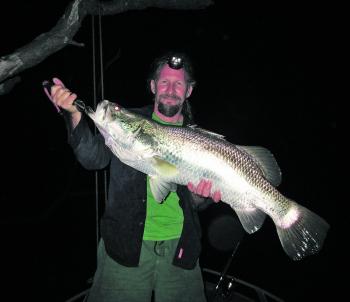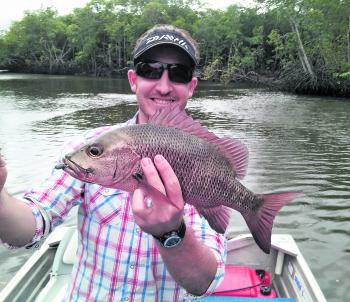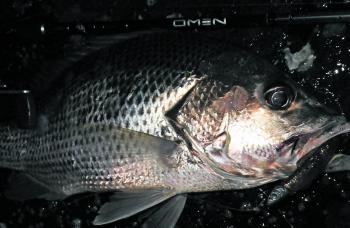Barra fever has reached epic proportions! The opening day of the barra season always sees the beaches, headlands and estuaries around Cairns crawling with human ants, all trying to get their first barra fix for the year.
The good news is there were a lot of barra sighted by divers in the lead-up to the opening of the season. Divers I know reported dozens of 20lb+ barra under the Palm Cove Jetty in early January and many more sightings along the headlands north of Cairns. The long spell of calm weather in late December and early January saw the dive brigade give all the local headlands, reefs and islands a good work over. The large number of barra sightings was certainly frustrating for divers but good news for anglers.
The other great news is that the nets will not decimate the spawning females, with the introduction of the Net Free Zone from False Cape to the northern end of Taylors Point on 1 November last year. The barra probably completed one spawning run around Cairns in late December, when we had over 500mm of rain around the northern beaches in about a week. There wasn’t quite as much rain around the city but probably still enough to trigger a spawn.
The best places to chase barra will be along the numerous headlands to the north and south of Cairns, around any structure towards the mouths of the estuaries and at any stream junction. The more rainfall we get, the more the bigger barra will congregate around the river mouths and headlands.
Golden snapper (fingermark) and mangrove jack have continued to bite in good numbers, especially along the headlands. They have mainly fallen to soft plastics worked along the bottom, but hard-bodied lures and livebaits have also accounted for a few. Right on dawn and dusk have been the main bite times of late, with a sprinkling of fish caught either side. This means in the morning you need to be fishing before the first sign of dawn in the sky (currently about 4.30am). In the evening you should fish until it’s pitch dark for the best results.
Jacks will continue to be active through the wet season and are a great target species at this time of year, as they can tolerate a wide range of water conditions. Fishing small soft plastics, minnows and prawn imitations in heavy structure, irrespective of the water conditions, will put you in with a chance to tangle with a red devil. They certainly prefer clearer water but will tolerate turbid conditions short-term. The good thing about targeting jacks with small lures or live baits is that it leaves the door open for a barra, golden snapper or grunter to gate crash the party. Fishing with dead baits is very effective on jacks but it does reduce your chances of catching an incidental barra or golden snapper.
School mackerel have been around in reasonable numbers as they harass the massive number of bait schools in the area. While the schools haven’t been exceptionally large there has certainly been a lot of them showing on the sounder and the surface. Many of the bait schools are down deep, so there hasn’t been much bird activity to give away their whereabouts. Even a single gull hovering or diving is sufficient sign that there is a bait school under them. Best results have come from either trolling close behind the boat, with the lures back only about 7m. Surprisingly, even though the bait is small most doggies have been taken on large lures up around the 20cm mark. The other method that produces the goods on schoolies is jigging small metal lures around the wrecks and bait schools.
The exceptionally calm weather has meant many anglers have headed to the reef, with mixed results. A few have hit the mother load but most have worked hard or more accurately, work hot, for a feed. The days have been searing on the water with the light breezes and clear skies, making an all-day trip a bit of a torture test. Overnighters have been popular for that reason, as well as generally providing better fishing. Fishing the deep water is certainly the go, with the water temperatures up shallow pushing and at times exceeding 30°C. Coral trout, large-mouth nannygai and red emperor will be around but not in great numbers. The upside is, what they lack in numbers is often made up for by size through the summer months.
Most of the run-through creeks along our beaches have opened up with the rain in late December and should remain open for some months, due to the combination of wet season rain and big tides around the new and full moons. The mouths of these creeks are great spots for the land-based angler to frequent, as all the local species, with the exception of golden snapper, are happy to feed in these areas, especially if the prawns are around. Any sign of jelly prawns or small bait prawns are a sure fire indication that the predators won’t be far away. The biggest challenge is often to match the hatch, with jelly prawns particularly difficult to imitate, unless you are a fly fisherman. Fish with as small a bait or lure as you can lay your hands on and you will be in with a chance. There are plenty of small prawn lures on the market nowadays.
Any heavy downpour will stir the mud crabs into action, so have the pots ready, along with a good supply of bait, for the inevitable downpours that happen in February. It is, after all, the wettest month of the year in the north.
Reads: 1441
Cairns anglers will be hoping to emulate Russell Woodfield’s efforts on barra.

Jacks, like this one caught by David Mayes, will continue to be active through the wet season and are a great target species at this time of year.





